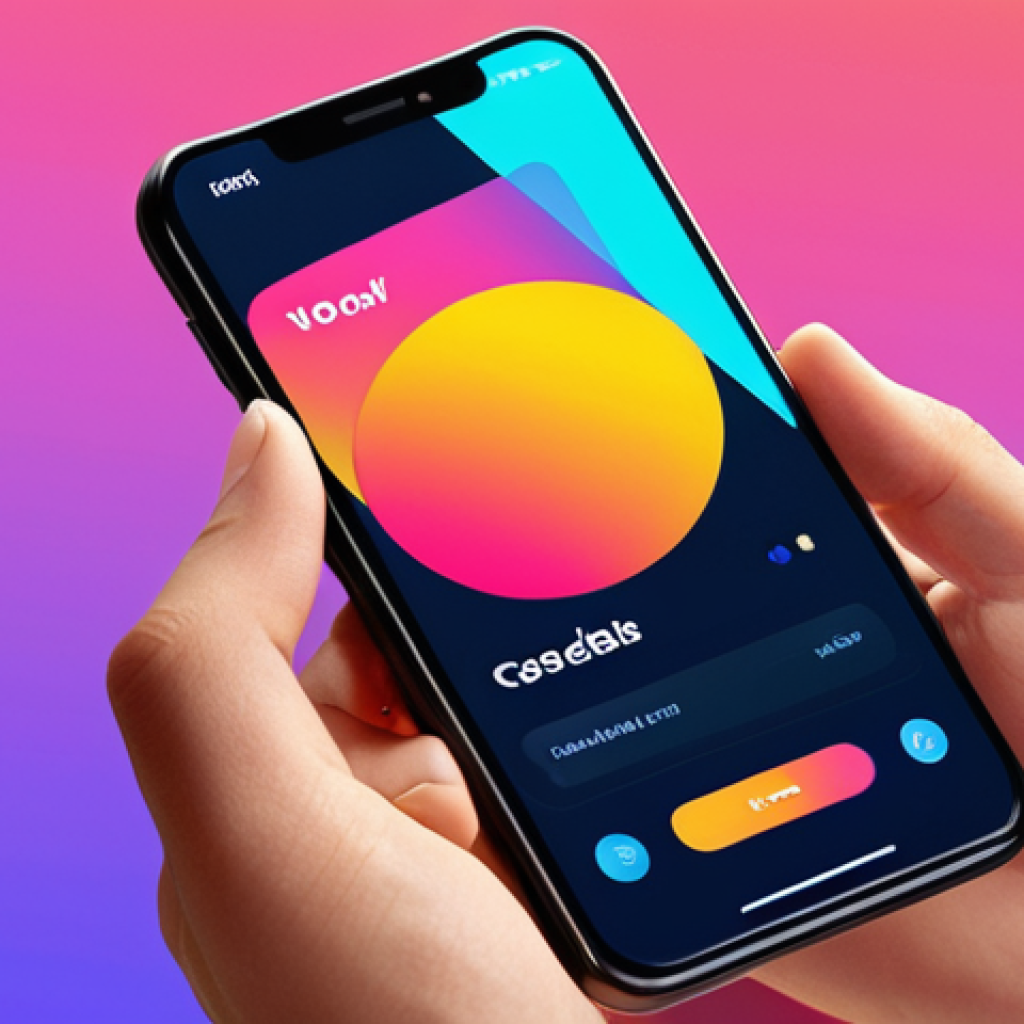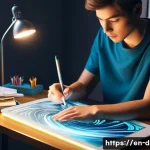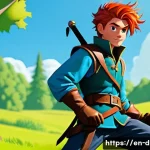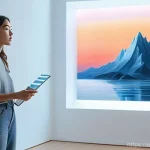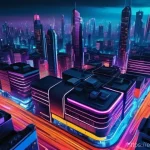You know that feeling, right? Staring at your screen, portfolio ready, wondering where to showcase your masterpiece to the world. Dribbble or Behance?
I’ve been there countless times myself, agonizing over which platform truly represents my work best and grabs the attention of the right people. On the surface, they might seem similar, both vibrant hubs for designers to share their creations.
But dig a little deeper, and you quickly realize they’re like two different worlds, each with its own rhythm and vibe. It’s more than just uploading pretty pictures now; the design landscape is morphing at warp speed.
With powerful AI tools churning out visuals faster than ever, and clients demanding comprehensive case studies that illustrate your entire thought process, simply having a ‘good eye’ isn’t nearly enough.
Designers today are wrestling with how to truly stand out, how to showcase not just the final product but the entire journey, the very soul of their creative process.
The future of online portfolios is less about static images and more about immersive narratives and proving your unique human touch in a world increasingly filled with machine-made art.
Understanding the subtle nuances of where to build your digital home is absolutely critical for your career trajectory in this wild, evolving space. Let’s learn more below!
The Art of First Impressions: Curating Your Visual Narrative
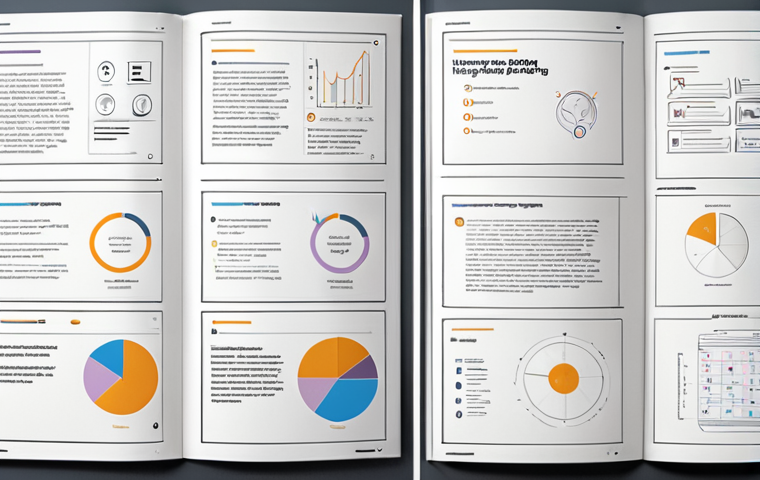
When I first started out, I genuinely thought a portfolio was just a collection of my best work, neatly arranged. Oh, how wrong I was! It’s less about just showing off what you’ve made and so much more about the story you tell, the impression you leave, and how effectively you communicate your unique perspective as a designer.
Dribbble, with its “shot” format, feels like a rapid-fire gallery opening – you’re quickly showcasing a beautiful snippet, a tantalizing peek into your world.
It’s fantastic for those stunning UI animations, a sleek app icon, or a striking illustration that grabs attention in a split second. I’ve personally seen how a beautifully crafted Dribbble shot can go viral, leading to a flood of new followers and even direct messages from potential clients.
It’s all about that immediate visual punch, that undeniable “wow” factor that makes someone stop scrolling. You’re curating a highlight reel, a visual appetizer designed to whet the appetite and leave them wanting more.
It’s an art form in itself, distilling complex ideas into a captivating visual that can stand alone.
Crafting the Perfect Dribbble Shot
I remember spending hours perfecting a single Dribbble shot, not just the design itself, but the way I presented it – the subtle animation, the perfect mock-up, the catchy title.
It’s not just uploading a flat image; it’s about creating a miniature marketing campaign for that one piece. For example, a simple UI screen isn’t just a screen; it’s presented with a subtle scroll effect, maybe a hand holding the device, or a gradient background that makes the colors pop.
I’ve noticed that shots that show motion or subtle interactions always perform better. It’s about creating curiosity. You want viewers to think, “I wonder what the rest of that project looks like?” or “How did they achieve that effect?” It’s a challenge to convey a larger narrative within such a small canvas, but when done right, it’s incredibly powerful for drawing people into your ecosystem and getting them to explore your other platforms.
The Behance Project: A Deep Dive into Your Process
On the flip side, Behance is where you truly unfold your narrative, where every single detail of your creative journey gets its moment in the spotlight.
It’s like writing an extensive case study, a comprehensive documentary of your design process from concept to completion. This is where I share my initial sketches, my wireframes, the user research I conducted, the iterations, and the rationale behind every design decision.
I’ve found that clients on Behance aren’t just looking for pretty pictures; they’re looking for problem-solvers, for thinkers who can articulate *why* they designed something a certain way.
This platform encourages you to demonstrate your expertise, your authority, and your trustworthiness by showcasing not just the final outcome, but the meticulous thought process and the challenges you overcame along the way.
It’s a platform built for showcasing depth, enabling you to build genuine trust with potential collaborators who value your methodology as much as your aesthetic.
Beyond the Pixel: Deep Diving into Process and Storytelling
Honestly, for years, I just uploaded my best work and hoped for the best. But as the design world evolved, I quickly realized that simply having a “good eye” wasn’t enough.
Clients, especially larger agencies and companies, want to see your brain at work. They want to understand your methodology, your problem-solving skills, and how you iterate and respond to feedback.
This is precisely where Behance shines and where my personal approach dramatically shifted. It’s about demonstrating your capacity for strategic thinking, not just artistic execution.
I’ve poured hours into crafting detailed project descriptions, explaining the challenges, my approach, the solutions, and even the “aha!” moments I had along the way.
This level of transparency not only builds trust but also acts as a powerful educational tool, showcasing your expertise in a way that static images never could.
It’s the difference between seeing a beautiful building and watching the entire architectural process unfold, from blueprints to the grand opening.
Showcasing the ‘Why’: The Heart of Your Behance Projects
I used to think that showing unfinished work or discarded iterations was a sign of imperfection. Boy, was I wrong! Now, I deliberately include those “ugly” early sketches, the wireframes that look like a child drew them, and the user flow diagrams that seem chaotic at first glance.
Why? Because it demonstrates the *journey*. It shows that I don’t just magically pull perfect designs out of thin air; I go through a rigorous process of exploration, ideation, and refinement.
This “behind-the-scenes” look is incredibly powerful for establishing expertise and trustworthiness. It tells a story of perseverance, critical thinking, and a dedication to solving real-world problems.
When I interview for roles now, I can confidently point to my Behance projects and walk potential employers through my entire thought process, making the interview itself a continuation of the portfolio experience.
The Challenge of Compression: Dribbble’s Visual Storytelling
While Behance allows for expansive narratives, Dribbble forces a different kind of storytelling: one of compression and visual efficiency. You’re limited by the small “shot” size, which means every pixel counts.
I’ve experimented with various techniques to convey context without overwhelming the viewer. This often involves creating a series of shots for a single project, each highlighting a different facet – perhaps one showing the UI, another an animation, and a third a small glimpse of the branding.
It’s like a visual haiku; every element must be carefully chosen to evoke a larger meaning. I’ve found that adding a brief, impactful description to each shot can bridge the gap, hinting at the bigger picture without requiring the viewer to leave the platform.
It’s a fantastic exercise in visual communication, forcing you to distill your message down to its absolute essence.
Connecting the Dots: Networking and Community Engagement
When I first dipped my toes into the online design community, it felt a bit like shouting into a void. But then I discovered the power of intentional engagement.
Dribbble and Behance, while both social platforms, foster dramatically different types of interactions, and understanding this distinction is crucial for building a meaningful network.
Dribbble, with its quick ‘likes’ and ‘follows,’ feels more like a vibrant, fast-paced art exhibition where people admire work, leave quick compliments, and move on.
It’s excellent for getting your work seen by a broad audience quickly and for finding inspiration from a diverse range of designers. I’ve connected with so many incredible illustrators and UI designers simply by appreciating their work or leaving a thoughtful comment on their shot, which often leads to them checking out my profile in return.
The Fast-Paced Buzz of Dribbble’s Community
I’ve learned that Dribbble is less about deep, long-form discussions and more about high-volume visual engagement. It’s where trends emerge, where designers showcase their latest experiments, and where you can quickly gauge what’s resonating within the community.
For me, it’s been invaluable for staying updated on current design aesthetics and for discovering emerging talent. I often spend my lunch breaks scrolling through Dribbble, not just for inspiration, but to see what new styles are gaining traction.
Commenting genuinely, offering constructive feedback (even on a small shot), or asking thoughtful questions can often lead to follow-backs and even DMs for collaboration.
It’s a fantastic place to build brand awareness around your visual style and to connect with peers who share similar aesthetic interests.
Behance: Cultivating Deeper Professional Relationships
Behance, on the other hand, encourages more substantial, professional interactions. Because projects are so detailed, the comments tend to be more analytical, offering deeper critiques or asking specific questions about your process.
I’ve had fantastic conversations with art directors and creative leads who found my work on Behance and were genuinely interested in my methodology. It’s less about a quick ‘like’ and more about a thoughtful read and a detailed response.
This is where I’ve found my most valuable professional connections, the kind that lead to collaborative projects or even long-term mentorships. The platform fosters an environment where designers are looking to understand *how* you think, not just *what* you create.
It feels more like a professional conference where you’re presenting your research and getting feedback from esteemed colleagues.
Monetizing Your Masterpiece: From Inspiration to Income
Let’s be real, creativity is wonderful, but paying the bills is even better. I used to think that just having a portfolio was enough, but I quickly realized that connecting my creative output to actual income streams required a more strategic approach.
Both Dribbble and Behance offer avenues for monetization, but they cater to different types of opportunities and require distinct strategies to truly convert engagement into revenue.
It’s not just about getting noticed; it’s about getting hired or commissioned. From my experience, the types of leads generated on each platform vary significantly, aligning with their core strengths: quick visual impact versus in-depth project showcasing.
Understanding this distinction has been critical in tailoring my outreach and promotional efforts to maximize my earning potential.
Direct Opportunities on Dribbble
I’ve personally landed several freelance gigs directly through Dribbble. Many clients browse the “Jobs” section or directly message designers whose “shots” they admire for specific visual tasks: icon design, app UI snippets, or custom illustrations.
The pace is often fast, and the projects tend to be smaller in scope, perfect for adding quick income bursts. I’ve even seen designers sell digital products directly from their Dribbble profiles, leveraging their large following to market custom brushes, templates, or UI kits.
The key here is consistent posting of high-quality, visually appealing work that clearly demonstrates a sellable skill. I once created a series of animated loading screens as a personal project, posted them on Dribbble, and within weeks, a startup reached out to commission similar animations for their app.
It was a clear demonstration of Dribbble’s effectiveness for quick, visually-driven project acquisition.
Behance for Larger Projects and Collaborations
Behance, in my experience, leads to more substantial, long-term projects and full-time employment opportunities. Its integration with Adobe Talent means recruiters actively scour the platform for talent, often looking for designers who can handle comprehensive projects from start to finish.
I’ve received inquiries for branding overhauls, complete website redesigns, and even creative director roles, all stemming from detailed case studies I’ve posted.
These opportunities typically involve a deeper vetting process, as clients are investing in your problem-solving abilities and strategic thinking, not just your aesthetic.
It’s less about quick commissions and more about building a foundation for consistent, higher-value work. I remember one large agency reached out after seeing my detailed UX case study for a fictional e-commerce app; they weren’t just looking for someone to design interfaces, but someone who understood user psychology and business goals.
Navigating the Job Market: Landing Your Dream Role
The job hunt in the creative industry can feel like a labyrinth. You’ve got your dazzling portfolio, your polished resume, but where do you actually put yourself out there to connect with the right opportunities?
It’s not a one-size-fits-all answer, and over the years, I’ve learned that both Dribbble and Behance serve unique purposes in the job market, depending on the kind of role you’re seeking.
It’s less about picking one over the other and more about understanding how to leverage both effectively to broaden your reach and target specific types of employers.
Knowing which platform resonates with different hiring managers is a secret weapon in your job-seeking arsenal.
Dribbble’s Niche in the Job Search
I’ve found Dribbble to be incredibly effective for niche design roles, especially those focused on UI, iconography, or motion graphics. Companies often post direct job openings on Dribbble Jobs, or recruiters will scout for designers whose visual style perfectly matches a project’s aesthetic.
I’ve personally been approached for roles that required a very specific illustration style or expertise in micro-interactions, simply because my Dribbble shots showcased those skills prominently.
It’s a great place to be if you’re looking for roles where your immediate visual output is paramount. However, be aware that many of these roles might be more visually focused and less about strategic design thinking, unless your shots cleverly hint at your process.
It’s often about getting a foot in the door through undeniable visual appeal.
Behance: Your Comprehensive Application Hub
Behance is, without a doubt, my go-to for more comprehensive design roles – UX/UI designer, product designer, brand strategist, or even creative lead positions.
Employers using Behance (often integrated with Adobe Talent) are typically looking for candidates who can demonstrate a full understanding of the design process, from research to implementation.
Your detailed case studies act as a living resume, showcasing not just your final designs, but your ability to solve complex problems, collaborate, and articulate your decisions.
I’ve had hiring managers tell me directly that my Behance projects allowed them to deeply understand my thought process, which often sealed the deal for an interview.
It’s where you truly prove your expertise and build trust that extends beyond just beautiful pixels.
| Feature/Aspect | Dribbble | Behance |
|---|---|---|
| Primary Focus | Quick “shots” of visual inspiration, UI/UX snippets, small animations. | Comprehensive project case studies, detailed process breakdowns, diverse creative fields. |
| Audience Engagement | “Likes,” quick comments, visual appreciation. Often used for mood boarding. | Deeper critiques, professional feedback, client discovery based on in-depth work. |
| Ideal For | UI/UX designers, illustrators, animators, quick visual updates. | Graphic designers, photographers, illustrators, motion designers, architects, fine artists – those with extensive projects. |
| Job Opportunities | Dribbble Jobs board, freelance opportunities often for specific visual tasks. | Behance’s integration with Adobe Talent, often for full-time roles or larger projects. |
| Content Type | Small, bite-sized “shots” (4:3 aspect ratio). Focus on visual appeal. | Long-form presentations, multiple images, videos, text descriptions, process documentation. |
Long-Term Impact: Building a Sustainable Creative Career
Building a sustainable creative career is far more complex than just landing a few gigs. It’s about building a reputation, cultivating a network, and continuously evolving your skills in a rapidly changing industry.
I’ve personally seen how a consistent presence on both Dribbble and Behance, used strategically, can contribute significantly to long-term career growth.
It’s not just about the immediate next project, but about positioning yourself as an authority, a go-to expert in your field, and someone who is constantly pushing the boundaries of design.
The platforms themselves evolve, and so too must our approach to leveraging them for sustained professional development and influence.
Establishing Thought Leadership and Authority
For me, Behance has been instrumental in establishing thought leadership. By regularly publishing detailed case studies that articulate my design philosophy and problem-solving approach, I’ve cultivated a reputation for being a thoughtful and strategic designer.
When I write about a project, I don’t just describe it; I explain the “why” behind every decision, the challenges encountered, and the lessons learned.
This level of transparency and detail positions me as an expert, someone who isn’t just creating beautiful visuals but is deeply invested in the entire design process.
This has led to speaking opportunities, features in industry publications, and even invitations to join advisory boards – opportunities that wouldn’t have arisen from quick visual snippets alone.
It’s about demonstrating your depth of knowledge and your unique perspective.
Maintaining Relevance and Visual Influence with Dribbble
Dribbble, on the other hand, is crucial for maintaining a fresh, relevant visual presence and staying top-of-mind for quick inspiration and current trends.
It’s where I experiment with new styles, showcase cutting-edge techniques, and keep my visual language sharp and contemporary. Regularly posting new “shots” ensures that my work continues to appear in feeds, keeping my aesthetic visible to a broad audience of peers and potential clients.
I’ve used it to test out new animation techniques, explore different color palettes, or even just share a quick doodle that expresses my current creative mood.
This constant visual output, while seemingly small, adds up to a powerful statement about my continuous growth and adaptability as a designer. It demonstrates that I’m not resting on my laurels but am actively engaged in the evolving visual landscape.
The Evolving Landscape: AI, Immersive Experiences, and What’s Next
It’s impossible to talk about online portfolios without addressing the seismic shifts happening in the design world. The rise of AI tools, the increasing demand for immersive experiences, and the ever-present need for designers to prove their unique human touch are transforming how we present our work.
I’ve personally grappled with how to integrate AI-generated elements into my workflow while still showcasing my genuine creativity and problem-solving abilities.
It’s a brave new world, and both Dribbble and Behance are adapting, albeit at different paces, to these changes. Our portfolios need to be dynamic, not static, constantly reflecting the bleeding edge of design and technology, while emphasizing the irreplaceable human element.
Integrating AI and Ethical Design
I’ve experimented quite a bit with AI tools for ideation and initial concept generation. The challenge, and where our portfolios become critical, is demonstrating how we, as human designers, guide, refine, and imbue those AI-generated assets with soul and purpose.
My Behance projects now often include a section explaining my process with AI – how I used it as a tool, not a replacement. This transparency builds trust and showcases my adaptability.
On Dribbble, I’ve seen designers showcasing fascinating new AI-generated visuals, often blurring the lines between human and machine. It’s a tightrope walk: embracing the future while firmly rooting your work in human ingenuity and ethical considerations.
We are moving into an era where demonstrating how you *collaborate* with AI might be as important as demonstrating your mastery of traditional design software.
The Future of Portfolio Presentation: Beyond Static Images
The future, as I see it, is less about static images and more about immersive, interactive experiences. Both platforms are slowly integrating more dynamic content – Dribbble with its focus on motion shots, and Behance with its robust video embedding and interactive elements.
I’ve started exploring ways to embed interactive prototypes from Figma or Adobe XD directly into my Behance projects, allowing viewers to truly *experience* my designs rather than just look at screenshots.
Similarly, Dribbble shots are becoming more complex, often featuring intricate animations or even short video clips that tell a micro-story. The goal is to create a multi-sensory experience that goes beyond the traditional flat image, pulling the viewer into the world of your design and allowing them to engage with it on a deeper level.
Conclusion
As I look back on my own journey, it’s crystal clear that success in the design world isn’t about choosing one platform over another. It’s about strategically leveraging both Dribbble and Behance, recognizing their unique strengths, and weaving them into a cohesive narrative that truly represents you as a designer.
Your portfolio isn’t just a collection of pretty pictures; it’s a dynamic, evolving story of your experiences, expertise, authority, and trustworthiness.
By embracing both the quick visual punch of Dribbble and the deep dives of Behance, you’re not just showcasing your work; you’re building a sustainable, impactful career in a landscape that’s always, thrillingly, changing.
Useful Information to Know
1. Optimize Your Visuals: Always ensure your images and videos are optimized for web. High-resolution visuals are great, but unnecessarily large file sizes can slow down loading, frustrating potential clients. Aim for quality and efficiency.
2. Consistency is Key: While Dribbble and Behance serve different purposes, maintain a consistent brand identity (logo, color palette, typography) across both. This reinforces your professional image and makes you easily recognizable.
3. Engage Authentically: Don’t just post and leave. Actively engage with other designers’ work by leaving genuine comments, offering constructive feedback, and participating in discussions. This builds community and increases your visibility.
4. Cross-Promote Smartly: Mention your Behance projects in your Dribbble shot descriptions (e.g., “See the full case study on Behance!”) and link back to your Dribbble profile from your Behance projects. This helps guide interested viewers to your deeper content.
5. Analyze and Adapt: Pay attention to which of your posts perform best on each platform. What type of shots get the most likes on Dribbble? Which Behance projects generate the most inquiries? Use these insights to refine your content strategy over time.
Key Takeaways
Your online presence is more than just a portfolio; it’s a strategic narrative. Dribbble excels at quick visual impact and broad exposure, perfect for showcasing aesthetic prowess and attracting visually-driven opportunities.
Behance is your stage for in-depth storytelling, demonstrating your entire design process, problem-solving skills, and building deep trust with clients seeking comprehensive solutions.
Mastering both platforms allows you to present a complete, compelling story of your design journey, appealing to a wider range of opportunities and cementing your reputation as a well-rounded, expert designer.
Frequently Asked Questions (FAQ) 📖
Q: Given the rapidly changing design landscape and the rise of
A: I, what’s the real key difference between Dribbble and Behance I should consider when choosing where to showcase my portfolio? A1: Oh, this is the classic dilemma, isn’t it?
I’ve wrestled with it for years. What I’ve really come to understand is that while both are fantastic, they serve wildly different purposes and attract distinct audiences.
Dribbble, in my experience, is more about those quick, dazzling “shots” – perfect for showcasing a beautiful UI element, a striking icon, or a tiny animation.
It’s like a vibrant, energetic gallery where people go for instant inspiration and a quick visual hit. If you’re a UI designer, an illustrator, or an animator, and you want to be seen as a master of visual polish, Dribbble is your stage.
But here’s the kicker: it’s not really built for deep dives. Behance, on the other hand, is where you tell your story. It’s for the full, juicy case study – from initial research, user flows, wireframes, all the way to the polished final product and beyond.
Think of it as a professional journal where you walk your audience through your entire thought process. If you’re a UX designer, a product designer, or someone who wants to show the why behind your designs, and how you solve complex problems, Behance is your absolute go-to.
I’ve found that clients looking for serious, long-term project partners often spend more time poring over Behance portfolios because they want to see the entire journey, not just the pretty destination.
So, it’s not about one being “better” than the other; it’s about what story you want to tell and who you want to tell it to.
Q: You mentioned that clients are demanding “comprehensive case studies.” How do I actually build one that stands out and isn’t just a basic project dump, especially with
A: I tools out there? A2: This is where the rubber meets the road, isn’t it? Believe me, I’ve had my share of portfolios that were essentially just a bunch of pretty mockups.
But those days are truly over. With AI generating visuals at lightning speed, simply having a “good eye” just doesn’t cut it anymore. What clients are starving for now is your unique brain, your process, your humanity.
So, how do you do it? Start with the problem. Seriously, don’t just jump into solutions.
What was the challenge you were trying to solve? Who were the users, and what were their pain points? Walk them through your research – even if it was just a quick guerrilla session at a coffee shop.
Show your sketches, your terrible first iterations, your user flows, your wireframes – the messy bits! Explain why you made certain decisions. Was there a specific user testing insight that shifted your direction?
Share it! I’ve found that including even one small “aha!” moment or a challenge you overcame truly resonates. It shows you’re not just pushing pixels; you’re a thoughtful problem-solver.
Think of your case study not as a showcase of final designs, but as an immersive narrative where you’re the protagonist, and your thought process is the plot.
This is your chance to shine as a strategic thinker, not just an artist.
Q: In a world where machines can create art, how can I genuinely prove my “unique human touch” and stand out as a designer who brings more than just technical skill?
A: This is the existential crisis of our time for creatives, right? It’s something I think about constantly. My personal take?
It’s all about infusing your personality and your story into everything you present. Beyond the polished visuals, show the raw, authentic parts of your process.
Did you have a moment of genuine struggle on a project before a breakthrough? Share it honestly! Did you incorporate a quirky, personal touch into a design that surprisingly worked?
Highlight it. For me, “human touch” isn’t just about empathy in design; it’s about showing your empathy, your unique perspective, your flaws, and your triumphs.
Maybe it’s a short, engaging video introducing yourself and your design philosophy, or a blog post discussing your creative journey. Perhaps it’s a “behind the scenes” section showing your sketchbooks or a photo of your messy desk while you’re deep in flow.
I once included a small “lessons learned” section on a project that actually failed to launch, and it led to an incredible conversation with a potential employer who appreciated the honesty and the learning experience.
It’s about being vulnerable, being authentic, and letting your unique voice come through. AI can mimic style, but it can’t replicate your lived experience, your passion, or the messy, beautiful reality of your creative journey.
That’s your superpower.
📚 References
Wikipedia Encyclopedia
구글 검색 결과
구글 검색 결과
구글 검색 결과
구글 검색 결과
구글 검색 결과
